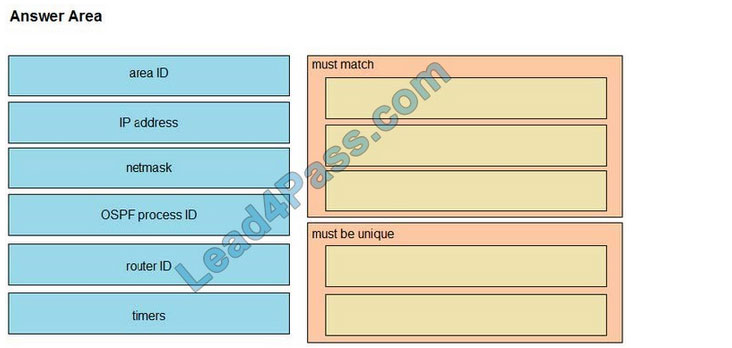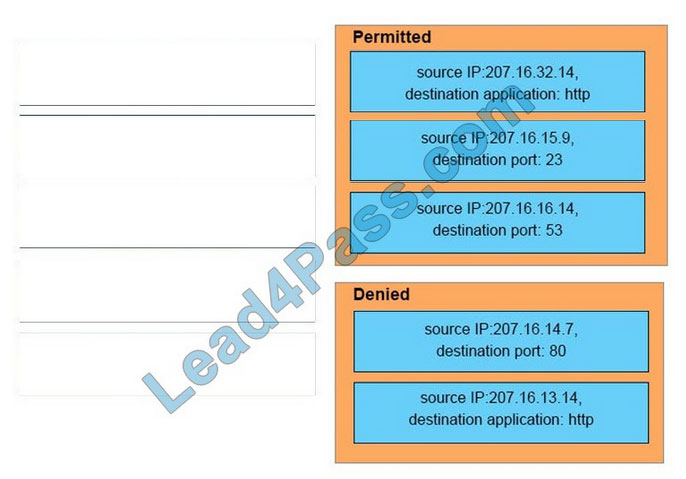
The newly updated Cisco 200-301 dumps contain 825 exam questions and answers that candidates can study using the 200-301 dumps PDF and 200-301 dumps VCE to help you successfully pass the 200-301 CCNA exam.
You are welcome to download the latest Cisco 200-301 dumps: https://www.leads4pass.com/200-301.html, leads4pass 200-301 dumps serve all candidates taking the 200-301 CCNA exam and guarantee you 100% Successfully passed the 200-301 CCNA exam.
Download the Cisco 200-301 PDF for free sharing online:
https://drive.google.com/file/d/1669m52Mt2e5wr9FiB0GOzK7hmvofmPig/
https://drive.google.com/file/d/1vcSGuFGU_3h4qF1f3SyCgiDhMpROZUMM/
https://drive.google.com/file/d/1vuGGkGYTHneDdEvy4_OiCvUayAIC0n7-/
Share the latest Cisco 200-301 dumps exam questions and answers for free
New Question 1:
DRAG DROP
A network engineer is configuring an OSPFv2 neighbor adjacency. Drag and drop the parameters from the left onto their required categories on the right. Not all parameters are used.
Select and Place:

Correct Answer:

New Question 2:
Drag and drop the threat-mitigation techniques from the left onto the types of threat or attack they mitigate on the right.
Select and Place:

Correct Answer:

In this attack, the attacking computer generates frames with two 802.1Q tags. The first tag matches the native VLAN of the trunk port (VLAN 10 in this case), and the second matches the VLAN of a host it wants to attack (VLAN 20).
When the packet from the attacker reaches Switch A, Switch A only sees the first VLAN 10 and it matches with its native VLAN 10 so this VLAN tag is removed. Switch A forwards the frame out all links with the same native VLAN 10. Switch B
receives the frame with an tag of VLAN 20 so it removes this tag and forwards out to the Victim computer.
Note: This attack only works if the trunk (between two switches) has the same native VLAN as the attacker.
To mitigate this type of attack, you can use VLAN access control lists (VACLs, which applies to all traffic within a VLAN. We can use VACL to drop attacker traffic to specific victims/servers) or implement Private VLANs.
ARP attack (like ARP poisoning/spoofing) is a type of attack in which a malicious actor sends falsified ARP messages over a local area network as ARP allows a gratuitous reply from a host even if an ARP request was not received. This
results in the linking of an attacker\’s MAC address with the IP address of a legitimate computer or server on the network. This is an attack based on ARP which is at Layer 2. Dynamic ARP inspection (DAI) is a security feature that validates ARP packets in a network which can be used to mitigate this type of attack.
New Question 3:
Drag and drop the Cisco Wireless LAN Controller security settings from the left onto the correct security mechanism categories on the right.
Select and Place:

Correct Answer:

Layer 2 Security Mechanism includes WPA+WPA2, 802.1X, Static WEP, and CKIP while Layer 3 Security Mechanisms (for WLAN) includes IPSec, VPN Pass-Through, Web Passthrough …
New Question 4:
DRAG DROP
Refer to the exhibit.

Drag and drop the networking parameters from the left onto the correct values on the right.
Select and Place:


The “IP route” and “IP addr show eth1” are Linux commands.
1.
“IP route”: display the routing table
2.
“IP address show eth1”: get depth information (only on eth1 interface) about your network interfaces like IP Address, MAC Address information
New Question 5:
DRAG DROP
Drag and drop the AAA functions from the left onto the correct AAA services on the right.
Select and Place:

Correct Answer:

New Question 6:
Drag and drop the IPv4 network subnets from the left onto the correct usable host ranges on the right.
Select and Place:

Correct Answer:

This subnet question requires us to grasp how to subnet very well. To quickly find out the subnet range, we have to find out the increment and the network address of each subnet. Let\’s take an example with the subnet 172.28.228.144/18:
From the /18 (= 1100 0000 in the 3rd octet), we find out the increment is 64. Therefore the network address of this subnet must be the greatest multiple of the increment but not greater than the value in the 3rd octet (228). We can find out the 3rd octet of the network address is 192 (because 192 = 64 * 3 and 192 < 228) -> The network address is 172.28.192.0. So the first usable host should be 172.28.192.1 and it matches with the 5th answer on the right. In this case we don\’t need to calculate the broadcast address because we found the correct answer.
Let\’s take another example with subnet 172.28.228.144/23 -> The increment is 2 (as /23 = 1111 1110 in 3rd octet) -> The 3rd octet of the network address is 228 (because 228 is the multiply of 2 and equal to the 3rd octet) -> The network address is 172.28.228.0 -> The first usable host is 172.28.228.1. It is not necessary but if we want to find out the broadcast address of this subnet, we can find out the next network address, which is 172.28.(228 + the increment number).0 or
172.28.230.0 then reduce 1 bit -> 172.28.229.255 is the broadcast address of our subnet. Therefore the last usable host is 172.28.229.254.
New Question 7:
Drag and drop the descriptions of file-transfer protocols from the left onto the correct protocols on the right.
Select and Place:

Correct Answer:

New Question 8:
Drag and drop the WLAN components from the left onto the correct descriptions on the right.
Select and Place:

Correct Answer:

The service port can be used for management purposes, primarily for out-of-band management. However, AP management traffic is not possible across the service port. In most cases, the service port is used as a “last resort” means of accessing the controller GUI for management purposes. For example, in the case where the system distribution ports on the controller are down or their communication to the wired network is otherwise degraded.
A dynamic interface with the Dynamic AP Management option enabled is used as the tunnel source for packets from the controller to the access point and as the destination for CAPWAP packets from the access point to the controller. The virtual interface is used to support mobility management, Dynamic Host Configuration Protocol (DHCP) relay, and embedded Layer 3 security such as guest web authentication. It also maintains the DNS gateway hostname used by Layer 3 security and mobility managers to verify the source of certificates when Layer 3 web authorization is enabled.
New Question 9:
Drag and drop the functions from the left onto the correct network components on the right.
Select and Place:

Correct Answer:

New Question 10:
Drag and drop the routing table components on the left onto the corresponding letter from the exhibit on the right. not all options are used.
Select and Place:

Correct Answer:

New Question 11:
Drag and drop each broadcast IP address on the left to the Broadcast Address column on the right. Not all options are used.
Select and Place:

Correct Answer:

Question 12:
An interface has been configured with the access list that is shown below.

On the basis of that access list, drag each information packet on the left to the appropriate category on the right.
Select and Place:

Correct Answer:

New Question 13:
Order the DHCP message types as they would occur between a DHCP client and a DHCP server.
Select and Place:

Correct Answer:

New Question 14:
DRAG DROP
Drag and drop the attack-mitigation techniques from the left onto the types of attack that they mitigate on the right.
Select and Place:

Correct Answer:

802.1q double-tagging VLAN-hopping attack: configure the native VLAN with a nondefault VLAN ID MAC flooding attack: configure 802.1x authenticate man-in-the-middle spoofing attack: configure DHCP snooping switch-spoofing VLAN-hopping attack: disable DTP
New Question 15:
DRAG DROP
Drag and drop the characteristics of networking from the left onto the correct networking types on the right.
Select and Place:

Correct Answer:

…
Download the Cisco 200-301 PDF for free sharing online:
https://drive.google.com/file/d/1669m52Mt2e5wr9FiB0GOzK7hmvofmPig/
https://drive.google.com/file/d/1vcSGuFGU_3h4qF1f3SyCgiDhMpROZUMM/
https://drive.google.com/file/d/1vuGGkGYTHneDdEvy4_OiCvUayAIC0n7-/
The above is only a part of Cisco 200-301 dumps exam questions and answers, you can use the above exam questions and answers to improve yourself, not only that, we welcome you to download the latest
Cisco 200-301 dumps exam questions: https://www.leads4pass.com/200-301.html (Total Questions: 825 Q&A), help you truly pass the 200-301 CCNA exam.
More IT certification blogs: [Amazon]awsexamdumps.com, [Oracle]oraclefreedumps.com, [Cisco]ciscofreedumps.com, [Microsoft]examdumpsbase.com, [Citrix]citrixexamdumps.com
[CompTIA]comptiafreedumps.com, [VMware]vmwarefreedumps.com, [IBM]ibmexamdumps.com, [HP]hpexamdumps.com, [NetApp]netappexamdumps.com, [Juniper]juniperexamdumps.com
[Fortinet]fortinetexamdumps.com



